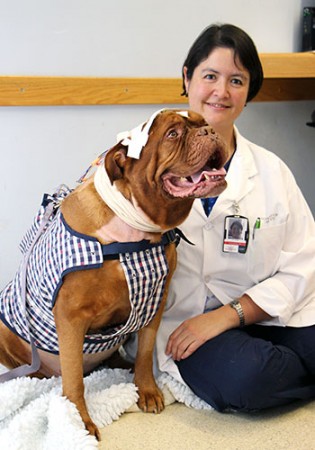
The boxer dog had an odd tremor. He would shake his head repeatedly from side to side as though he was saying “no.” Sometimes he would do this for 10 minutes, but the owners could interrupt the episode by telling him to sit and giving a treat. However, after he gobbled down the treat, the head shaking would often start again.
Veterinary neurologist Fiona James, a professor in the Ontario Veterinary College’s Clinical Studies Department, says unusual behaviours like this can be tough to diagnose. “It’s hard to tell if it is a behaviour problem, a stereotypy, muscles twitching or perhaps a seizure,” she says.
But now new answers are available. James has adapted mobile technology that allows her to collect data on what is going on in a dog’s brain by performing an electroencephalogram or EEG while the dog is awake and moving, even chasing a ball in a field.
Prior to this new technology, veterinarians trying to diagnose epilepsy would do an EEG with the dog highly sedated or anaesthetized. “The problem is that when they’re unconscious, there isn’t much activity in the brain,” says James. Often no seizures could be detected.
Building on work by the late Prof. Roberto Poma, who recorded dogs while awake but tethered to the EEG machine, James has created a backpack that is worn by dogs to record brain activity as they move around normally. Her inspiration: the systems used to monitor children by Dr. Miguel Cortez, a neurophysiologist at Toronto’s Hospital for Sick Children.
With this technology, James was able to determine the head-shaking boxer was actually having a seizure when he made this movement repeatedly. “It was unusual because seizures typically can’t be interrupted, but these ones could be,” she says. Of the 10 dogs in her study, four actually did the head shaking with their backpacks on, and seizure activity in the brain was seen in all four.
“The big impact of this new technology is when the dog is doing something weird, and we aren’t sure if it’s having seizures or not,” she says. She recently saw an elderly retriever who was having both ears twitch repeatedly. Her mobile EEG discovered these were seizures. Another dog with a recurring twitch of the jaw, though, showed no seizure activity. Without the EEG, it would have been difficult to know what was going on and how to treat the animal.
James’ work is part of OVC’s Comparative Epilepsy Program, which uses epilepsy research in dogs to help better understand epilepsy in humans. Research collaborators include Miguel Cortez from SickKids; Stephanie Dugas’ work at the University of Montreal Faculty of Veterinary Medicine; Hannes Lohi and Tarja Jokinen from the University of Helsinki; Andrea Fischer of Ludwig Maximilian University in Munich; and Sean Sanders of Seattle Veterinary Services.
She recently presented a paper on this topic at the annual symposium run by the European College of Veterinary Neurology and the European Society for Veterinary Neurology, where it was awarded Best Oral Scientific Presentation.